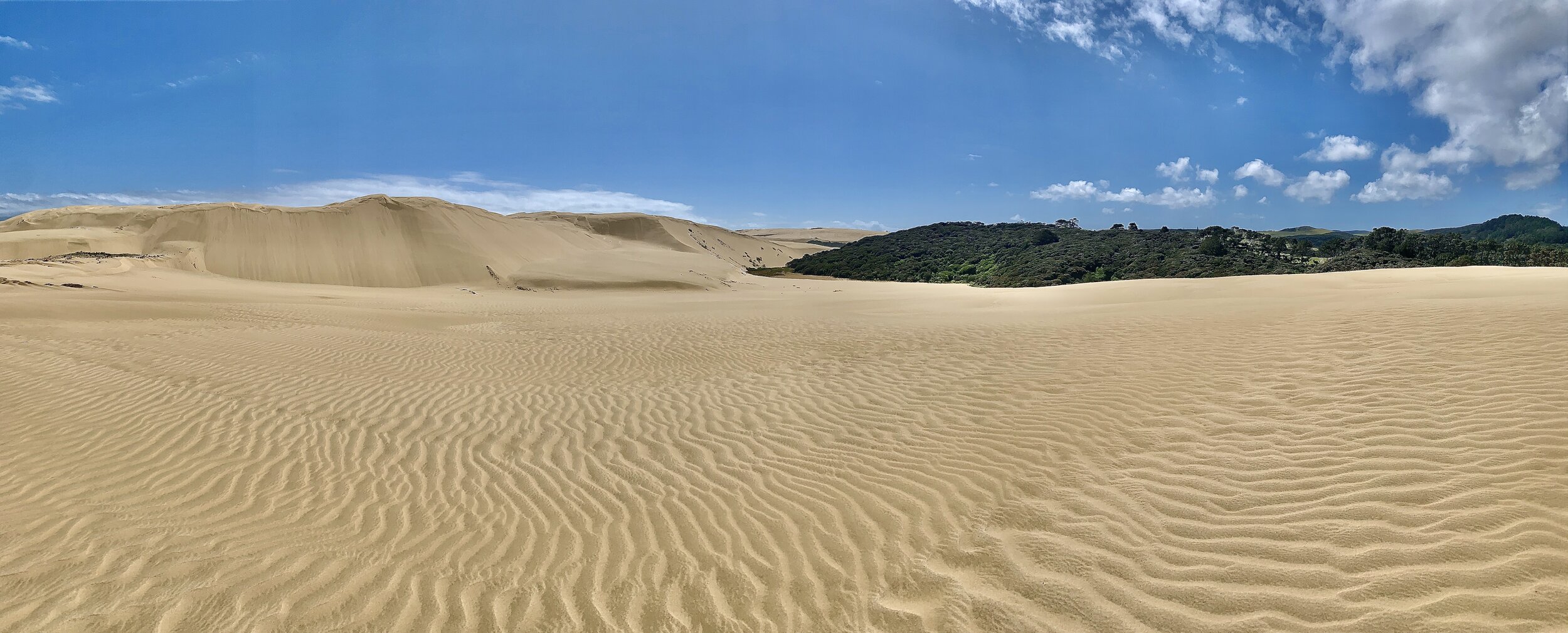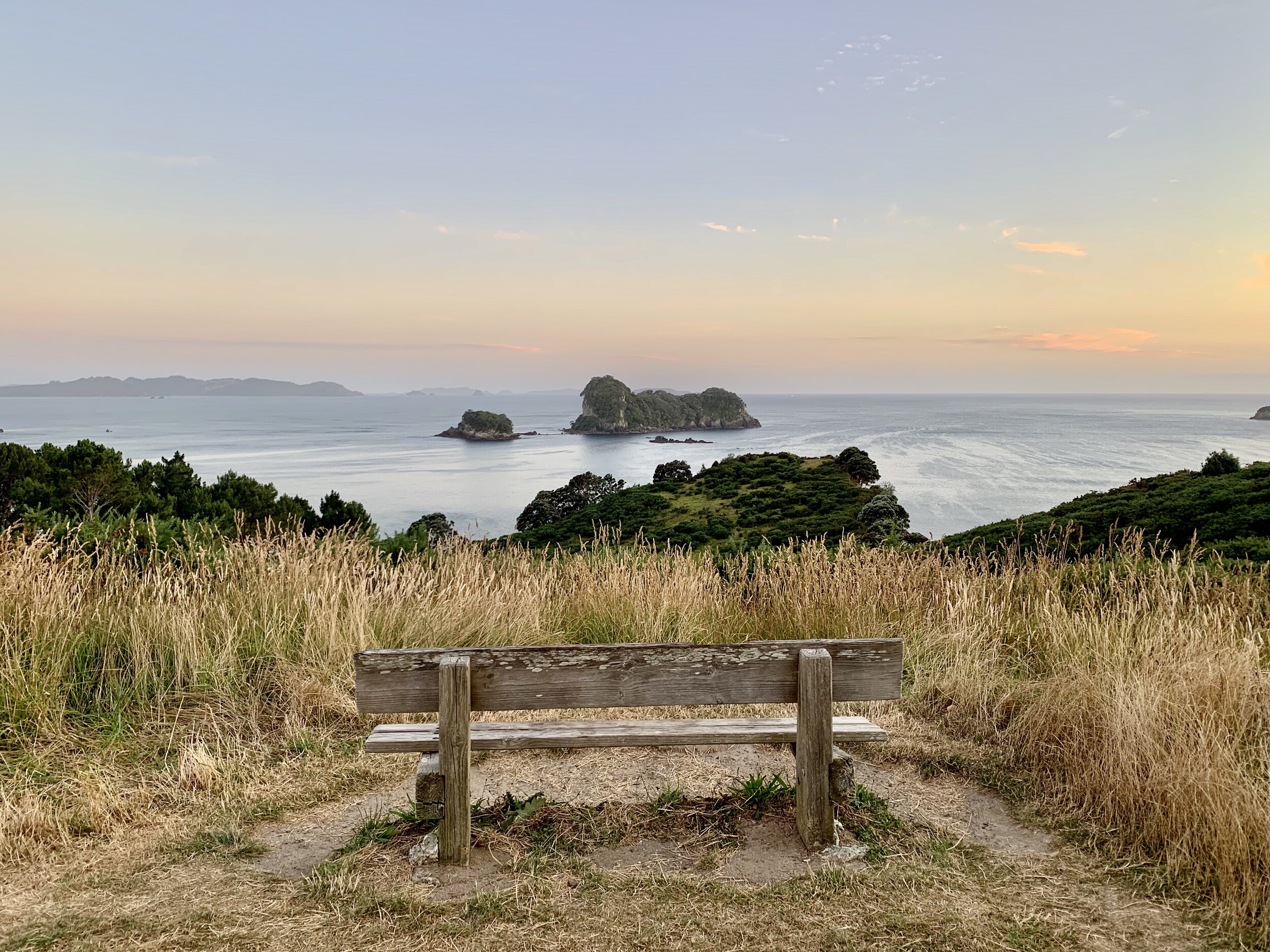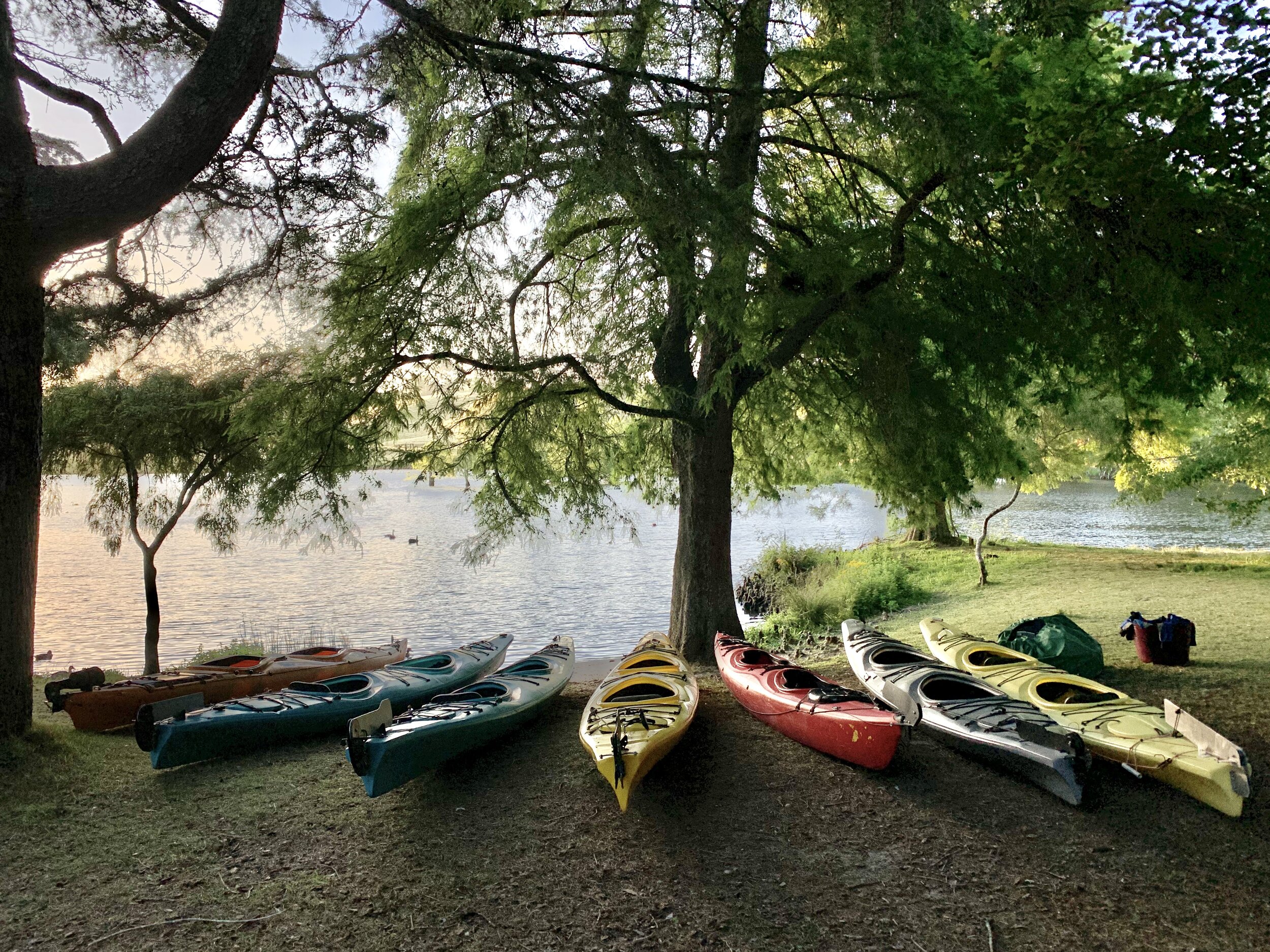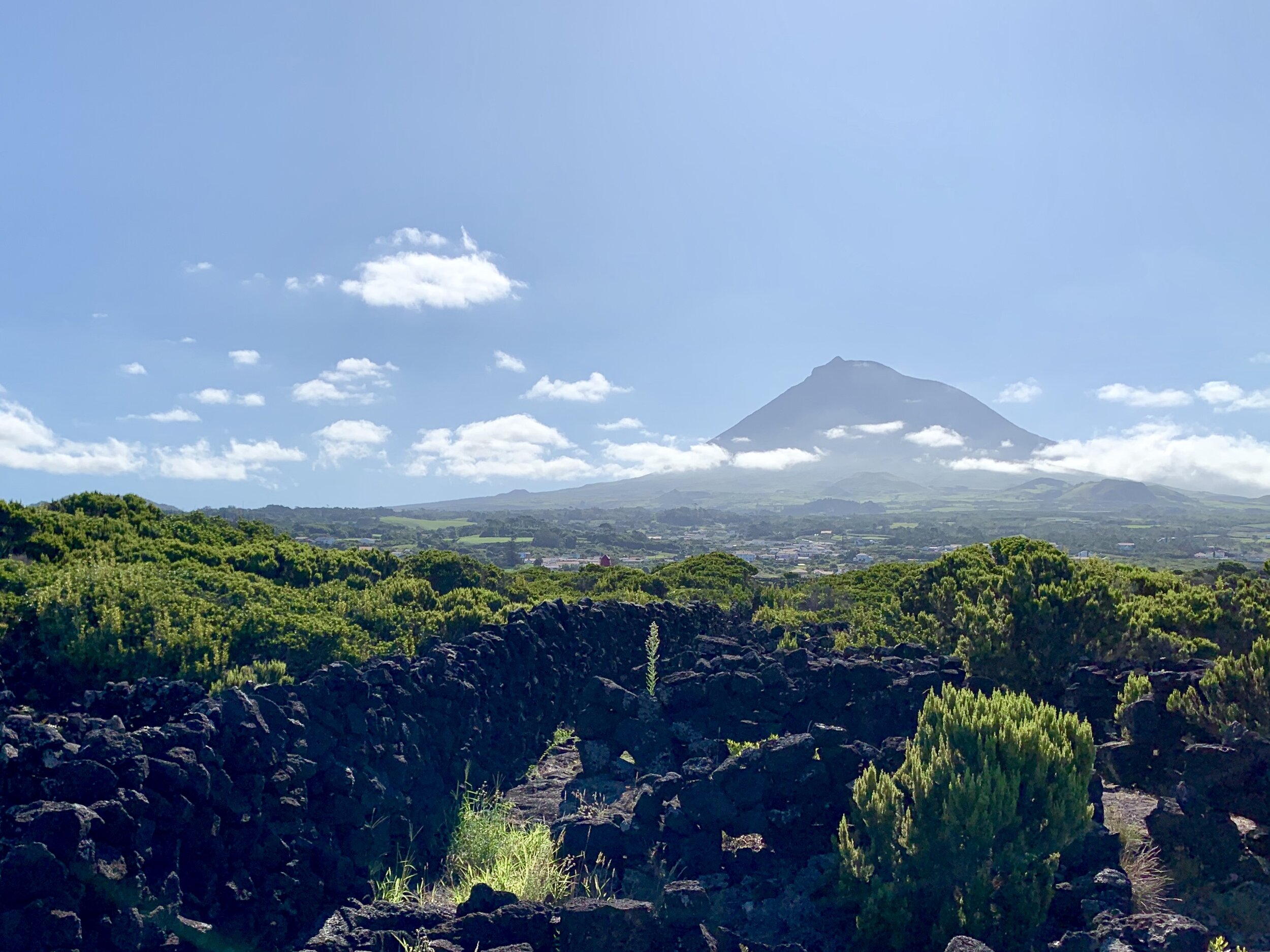If you’ve read my previous post about New Zealand, you’ll know I fell for the country pretty hard when I visited the North and South islands in a whirlwind two weeks. I went back last month for more, this time spending two weeks in the northern parts of the North Island, which seemed fitting for summertime. It is truly one of my favourite countries in the world: nowhere else is there such a perfect combination of diversity of landscape, little crowding, and amazing local food.
I’ve broken the below into three regional sections; feel free to skip ahead to Auckland & Waiheke, Northland or Waikato & Bay of Plenty.
Sunrise at Cathedral Cove
Auckland & Waiheke
After landing in Auckland, I checked into my cozy Airbnb near the waterfront and strolled over to Shucker Brothers for a feast of local oysters and fish & chips. The following morning, after some light bites at the Auckland Fish Market, I took Fullers ferry over to Waiheke island, known for its vineyards and fresh seafood, for a day trip. Just 30 min each way, the ferry makes the island incredibly accessible, and it’s advisable to rent a car to visit the different vineyards. I stopped for a quick breakfast at Solar Eating House with nice views overlooking Oneroa Bay before continuing eastward towards Man O’ War vineyards, as the paved road turned to gravel and the scenery becoming increasingly wider expanses of green dotted with sheep. There’s a calm bay with a thin stretch of pebbly beach here, which in the summertime fills with boats, swimmers, and kayakers. The wines at Man O’ War are some of the best on the island, with crisp, minerally whites and peppery Syrahs.
The beach by Man O’War vineyards, Waiheke Island
Vineyards on Waiheke Island
More food may be in order prior to trying more wines, and fortunately Poderi Crisci, run by a Neapolitan named Antonio, is not far away. A picturesque garden setting filled with the smell of jasmine and lavender welcomes you to your table, and traditional Italian staples are on offer. Alternatively, head back towards Onetangi Bay for a delicious seafood spread at Three Seven Two, which has a fantastic indoor/outdoor layout and overlooks the wide stretch of beach. The oysters were some of the best I had in New Zealand, and the wine list is superb.
Bird’s eye view of Waiheke Island
For something a bit different, check out Casita Miro, which feels like stepping into Parc Guell in Barcelona. The wines are decent, but the views make it worth a stop. For better wines, head to Tantalus and the neighbouring Stonyridge, which I followed with a quick stop at the Te Matuku Bay seafood market for another dozen local oysters. Cap off the day at Cable Bay Vineyards, with views of Auckland in the distance. For dinner, back in Auckland, I thoroughly enjoyed the lamb chop at Giraffe together with a friend who flew in to join me for the remainder of the trip.
Northland
Feeling full of oysters and lamb and wine, a rare and happy feeling, the following day we made our way north towards Matapouri, the jumping off point for the Poor Knights Islands, one of New Zealand’s best dive sites. En route, we stopped at the Kaiwaka Cheese shop to sample some local cheeses and other products: the manuka smoked cheddar and jalapeno gouda were particularly tasty. Further north, a quick hike led to the scenic Whangarei Falls, and nearby was the highlight of the day: Abbey Caves. A set of 3 caves reachable from the road via a short walk, these are particularly special because they aren’t commercialised and are filled with glowworms! To the uninitiated, glowworms are not actually worms, but rather larvae of fungus gnats (a much less glamourous term) that produce a bioluminescent blue-green glow. Some of the entrances to the caves are a bit tight, and the caves can be quite wet, so wear appropriate clothing and footwear (ideally water shoes or hiking shoes that can get wet, as well as a headlamp). Turn off your lights once well inside and enjoy the spectacle!
Our Airbnb near Matapouri was clean and well-located to the dive shop the next morning. We went with Yukon dives, and the boat was one of the nicest dive boats I have ever been on, complete with an upper outside area and a lower, fully-enclosed space full of comfortable bean bags and pillows. Beware, however, the water temperatures, which were at just 17C. These are drysuit diving waters, though the dive shop will assure you that everyone is fine in the 6.5mm wetsuits and hoods they supply. I insisted on layering an additional 3mm wetsuit on top of that, and I was still absolutely freezing within about 60 seconds of entering the water. The water was relatively choppy, though underneath the surface, the sway of the large-leafed, bright yellow and green algae was mesmerising. Large schools of fish and stingrays abounded, and multiple swimthroughs surrounded by the yellow algae truly made this a memorable divesite. In the shallows, caverns along the islands make for spectacular backlit window vistas onto the depths.
Resident emus at Raewyn & Rosco’s farmstay
Homemade Christmas dessert at Raewyn & Rosco’s farmstay
One of the most memorable Airbnbs of the trip was Raewyn & Rosco’s farmstay in Waiharara, where I was lucky enough to be over Christmas. Their dog Jess came out to greet me, nearly jumping into my car. They joked that since they didn’t have much family in the area, they had rented Americans to entertain them over the holidays. But they have many animals to make up for it: emus, cows, pigs, and ducks roam about, and the property borders a scenic creek upon which you can canoe. They cooked a fantastic Christmas dinner that we were invited to share in, and their breakfasts were the best of the trip. Raewyn & Rosco’s hospitality made me feel right at home despite being thousands of miles away from my own family.
The next day, we took an incredibly scenic road trip up to Cape Reinga, the northernmost point of New Zealand. It is where the Tasman and Pacific seas meet in a thunderous mix of greens, blues, and greys, and it’s a place of special significance to the Maori, New Zealand’s indigenous people: it is the point where the spirits of the dead enter the underworld. A stunning hiking path leads from near the lighthouse at the end of the peninsula to the completely wild Te Werahi beach. Dress in layers and wear sunscreen; conditions can change quickly.
Cape Reinga with a view to Te Werahi beach
Tasman Sea, Cape Reinga
Cape Reinga
A short drive away are the equally stunning Te Paki giant sand dunes. You’d not be remiss to think you could be somewhere in the middle east, and yet all of these incredibly varied landscapes are in just one part of one small country. Bring a board to coast down the dunes, or simply enjoy getting lost in the alien landscape.
Te Paki sand dunes
Fun in the dunes
Should you be craving a swim after the dryness of the dunes, head to nearby white sand Rarawa beach. If you’ve got a 4x4, you can actually drive onto the beach if you’d like. Kitesurfing is possible here as well if the conditions are right. We also checked out the much windier 90 mile beach (it truly does stretch as far as the eye can see in either direction) on the windward side of the peninsula, where tides can change quickly and more than a few cars have gotten stuck.
Rarawa beach
Kauri tree, Puketi Forest
Our next stop was another farmstay Airbnb further south in Ruawai. En route, we stopped at the Mangonui fish shop for some fish & chips, followed by the Puketi Forest for a short loop hike through a large grove of the currently endangered kauri trees, a species endemic to New Zealand. These large behemoths are reminiscent of California redwoods, but are currently being killed off by an incurable pathogen that can be spread in a single pinhead of soil (typically due to human activity). Signs and spray canisters at the start of trails instruct you to wash and disinfect the soles of your shoes to help prevent spreading the disease.
The road from Puketi to Ruawai was one of the curviest and emptiest of the trip, and a true pleasure to drive along. Upon reaching Pete & Sara’s farmstay, we were met by Pete, who promptly took us on a short hike to Tokatoka peak to enjoy the vista over the surrounding plains together with his dalmatian, Bella. A former dairy farmer, Pete’s boundless energy and enthusiasm for hosting visitors from around the world was infectious. He introduced us to the alpacas, sheep and donkeys on his farm and showed us how to feed them, and after a home-cooked dinner, we wheeled out his large telescopic to look at the clear night sky largely free of noise pollution. I woke up at 6am to join him at a neighbouring dairy farm where I learned about the process and even milked a couple of cows. Northland is truly New Zealand at its best.
Waikato & Bay of Plenty
From the rolling hills of Northland, we headed east to the Coromandel peninsula, known among Kiwis for its spectacular beaches and stunning cliffside walks. The drive there along the Firth of Thames is a stunning one and worth the slight detour from the main highway road. Stripes of aqua, turquoise and deep blue merge into each other, and a stroll through Waitawa Regional Park can be a great place to stretch your legs.
New Chums beach, reachable via a short hike
Coromandel itself is a cute seaside town and a nice spot for a stroll. I picked up some local cheeses and snacks at The Coromandel Smoking Co, and Umu Cafe serves up tasty breakfasts. We unfortunately didn’t have enough time to head up to Fletcher Bay and the Coromandel Coastal Walkway, but it is supposed to be a spectacular day hike. We did do a short walk along the coastline to reach New Chums Beach, which was perhaps one of the prettiest beaches of the trip (it is frequently voted one of New Zealand’s most beautiful beaches). From there, we stopped off for a daily dose of oysters at Salt Restaurant in Whitianga and enjoyed lazing on Hahei beach as afternoon turned to twilight and the sun disappeared behind us.
Bench with a view near Cathedral Cove
Cathedral Cove
Tree groves at Cathedral Cove
The following morning, I woke up before sunrise to walk to Cathedral Cove before the crowds. It was well worth it, as there were just a few others there, and the lighting was spectacular for photography. Incredibly crowded and hence skippable, however, was Hot Water Beach. There are a number of other spots where you can enjoy the thermal heat without the crowds (more on that later). Breakfast at Flatwhite in Waihi features a great view over the ocean and delicious food, and we were lucky enough to be in town for the weekly farmer’s market, where we purchased some eggs and avocados for the coming days.
Also well worth a stop is the Leveret Estate winery, which features award-winning and reasonably priced wines as well as very kind and patient salespeople. From there, we checked into our Airbnb in Tauranga (with a hot tub!), where we were welcomed by the very kind Pete and Karen and nice views over the surrounding area. We headed to Waimarino Adventure Park for an evening kayaking trip to McLaren Falls Park, complete with more glowworms. We set out in small groups of kayakers as the last rays of the day illuminated the lake and its numerous black swans and headed upstream to a few channels where glowworms illuminate the surrounding rocks. It was truly a magical evening.
Kayaking in McLaren Falls park
Sunset at Mt Maunganui beach
The following morning, I set out early to complete the Tarawera Trail, a 15k one-way hike along Lake Tarawera to Hot Water Beach, which, as the name implies, is a thermally heated beach on the lake where you can dig your own hot water pools or simply swim in heated areas of the lake by the shore. You book a water taxi to take you back from here to where you parked your car. The hike will take you through lakeside bushland and varied tree groves, featuring a number of intermittent climbs. The swim at the end of the hike is a relaxing reward, though be sure to book your water taxi in advance, as it runs only if it’s been booked.
Tarawera trail
Hot Water beach, Lake Tarawera
The following morning was New Year’s Eve, and in an effort to show off some dewy skin, we booked a mudbath and sulphur bath at the aptly named Hell’s Gate. A walk through the area takes you through various bubbling pools and beautiful colours from the bacteria that survive in this extreme temperatures before you settle into the mudbath. An attendant will explain the best way to apply the mud, and after 20 minutes, you are whisked off to the sulphur pools (bring an old bathing suit, as you will likely never be able to wash out the smell) to allow your skin to further soften.
Waimangu Volcanic Valley
Afterwards, I hiked through the nearby Waimangu Volcanic Valley, which features numerous spectacularly coloured pools and streams due to the underlying thermal activity in the area. In the evening, we enjoyed the small fireworks show over Lake Taupo and lingered on the beach, parts of which are also thermally heated. It was a fitting end to a spectacular decade.
Kayaking on Lake Taupo
Mine Bay Maori rock carvings, Lake Taupo
I started off the New Year the following morning with a 5k kayak (each way) from Acacia Bay (hire your own kayak or join a tour) to the Maori rock carvings at Mine Bay. Kayaking will take about 75 minutes each way, so it’s not a bad idea to bring along a friend to make it a bit easier on the arms. The rock carvings are quite large and intricate, and the views of snow-capped Mt Tongariro, Mt Ruapehu and Mt Ngauruhoe in the distance over Lake Taupo make the trip even more spectacular.
Red Crater, Tongariro Alpine Crossing
Emerald Lakes, Tongariro Alpine Crossing
Tongariro Alpine Crossing
Of course, one of the most popular activities in the area is the 20k Tongariro Alpine Crossing hike. Last time I visited New Zealand, strong winds prevented me from doing the hike, but this time the weather was on my side. I booked a one-way shuttle from the Ketetahi car park to the start of the trail with Tongariro Expeditions and found myself starting the hike just after 6am as the golden orb of the sun rose into a hazy morning. The landscape varies from light brush and volcanic rock to something best described as lunar to thick forest, and temperatures vary accordingly; I was grateful for my gloves and windproof jacket at the start of the hike, but I’d shed most of my layers about halfway through. The climax, with the aptly named and spectacularly hued Red Crater coming into view, occurs about halfway through the hike. Soon after, the three bright Emerald lakes steal the show, followed by a steep scramble that leads into the seemingly never-ending descent.
Mountain biking is also on offer in the area, and we checked out some of the trails that form the Craters of the Moon geothermal area as well as past Huka Falls and up the Waikato River. You can rent bikes from FourB, and take a dip in the Warm Water Lake area of Lake Taupo for a soothing reward afterwards. I very much enjoyed the seafood at the Edgewater Restaurant with views overlooking the sunset on the lake in the evening, and the lamb and scallop risotto at Vine Eatery were one of my favourite meals of the trip.
Sunset, Lake Taupo
Abseiling into the Lost World cave, Waitomo
On our last day in New Zealand, we did the Lost World tour with Waitomo Adventures, during which you abseil about 100 metres down into a wet cave system and something that truly does look like a long-forgotten world. I was happy to have selected the 4-hour rather than the full day tour: half a day gives a nice highlight of the experience and does not require wearing a wetsuit and getting completely wet. There are glowworms here, too, and the cave features beautiful vistas looking back through the natural window at the entrance. Keep in mind that what goes down into a cave must come up, and there’s a ladder with over 100 rungs that you’ll have to climb at the end to get out.
Afterwards, we enjoyed cups of locally grown tea and some light snacks at the Zealong Tea Estate en route back to Auckland, where we feasted on cloudy bay clams in a coriander sauce along with fresh oysters at Depot, and lingered over creative cocktail creations at John & May’s. We had a great night’s sleep at our Airbnb in Auckland, which featured amazing views of the city, a hot tub, and yes, a trampoline. The following day, the sky had turned an unearthly yellow hue due to the Australian wildfires. It was a stark reminder that despite being endowed with all the beauty in the world, New Zealand is still affected by human (in)action, and what we do directly affects the world around us.
Auckland Airbnb with a view
Where to eat & drink
Shucker Brothers, Auckland
Auckland Fish Market, Auckland
Giraffe, Auckland
Depot, Auckland
John & May’s, Auckland
Solar Eating House, Waiheke Island
Man O’ War vineyards, Waiheke Island
Poderi Crisci, Waiheke Island
Three Seven Two, Waiheke Island
Casita Miro, Waiheke Island
Tantalus, Waiheke Island
Stonyridge, Waiheke Island
Cable Bay Vineyards, Waiheke Island
Kaiwaka Cheese shop, Kaiwaka, Northland
Mangonui Fish Shop, Mangonui, Northland
The Coromandel Smoking Co, Coromandel, Waikato
Umu Cafe, Coromandel, Waikato
Salt Restaurant, Whitianga, Waikato
Zealong Tea Estate, near Hamilton, Waikato
Edgewater Restaurant, Taupo, Waikato
Vine Eatery, Taupo, Waikato
Flatwhite, Waihi, Bay of Plenty
Leveret Estate winery, Katikati, Bay of Plenty
Map of the approximate route driven (roughly 2,800km in total)

















































